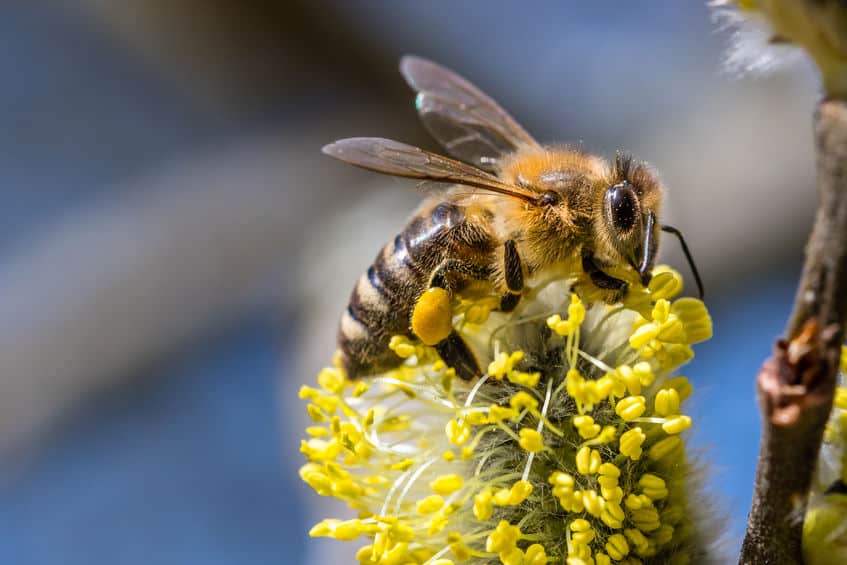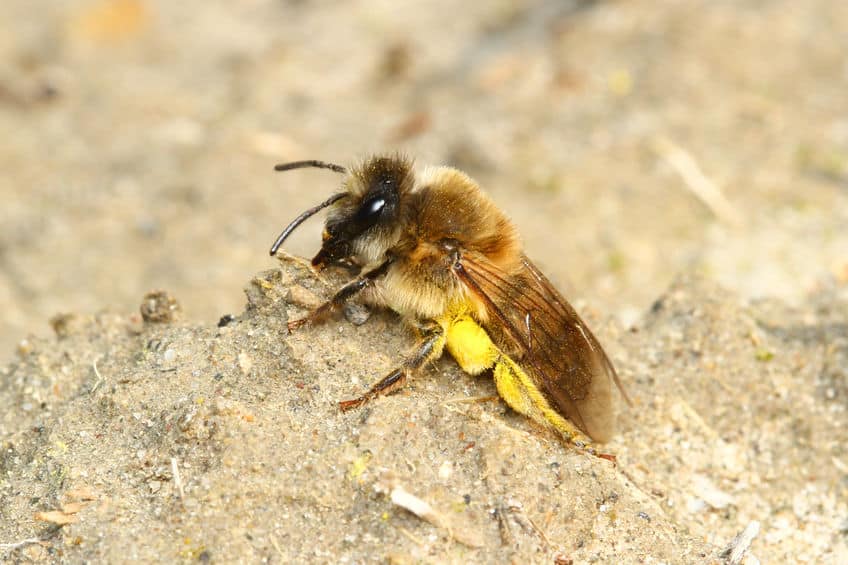Honey bees are the most widely used insects across the world. They are fantastic pollinators and the fruits of the hive offer wax, honey, and propolis. Mason bees are becoming increasingly popular for backyards and orchards alike, but these two types of bees are almost entirely the opposite in every single way. So what’s the difference? Why might someone choose one type of bee over the other?
Honey bees are a social species that operate with a queen and hives. They have a striped body and painful sting. By contrast, mason bees are solitary and lay their eggs in small nests within crevices. They are smaller than honey bees and do not have a painful sting. Unlike honey bees, mason bees do not produce honey as they do not overwinter as adults. Mason bees are, however, more productive pollinators than honey bees due to having scopa hairs and because they visit a greater variety of flowers.
Read on for a more detailed comparison of these fascinating insects.
Appearance
Close your eyes and imagine a honey bee. Easy, right? Four little wings, a sharp stinger, hairy bodies, alternating stripes; the honey bee is an incredibly popular symbol. Mason bee imagery isn’t nearly as common, especially since many species in the Osmia genus tend to look like fuzzy black flies with metallic abdomens. Mason bees shouldn’t be dismissed so easily, though. There are over 300 species, and some of them boast amazing appearances. Osmia cobaltina for instance, has an incredible blue exoskeleton.

The morphological differences between the bees don’t just stop at their colors; drones are male honey bees, and they are easily recognized for the large eyes and broad bodies. For mason bees, the males are smaller than their female counterparts.
Honey bees have “pollen baskets” on their hind legs, and they will push pollen grains to this basket and use saliva to stick them together. The long distances that honey bees will travel away from the hive make this an efficient method of transporting food back home. Mason bees, as well as most solitary bees, have something that honey bees lack; scopa hairs. These scopa are microscopically branched hairs that pick up pollen exceptionally well and will leave the bee covered in a thick powder of the grains. Honey bees are covered in hairs as well—around 3 million strands!—but lack the scopa that solitary bees boast.

Do both mason and honey bees sting?
Mason bees are prized for their gentleness and almost inability to sting. While a honey bee sting can result in a painful, sometimes life-threatening experience, the mason bee sting is comparable to that of a mosquito bite in terms of pain. The mason bee does not have a barbed stinger, so she can sting more than once, but the stingers are small and carry very little venom. They also have a hard time penetrating human skin and are only known to sting when being accidentally crushed or roughly handled.
Lifecycle
A typical honey bee hive can contains tens of thousands of bees, and includes a queen, drones, and workers. The workers are all female but a pheromone released by the queen inhibits the reproductive abilities of all the workers, making her the sole egg-layer. She is also the only bee able to mate with drones; even if her pheromones aren’t present, the workers cannot mate and thus cannot lay female eggs.
The lifespan of a worker depends on the time of year; during the warmer seasons they will live five or six weeks, but during the winter they can extend their lives up to six months. A queen can live for over two years before she becomes too old or is unable to lay anymore eggs. Drones have short lives. Their only purpose is to mate with a queen, and the act usually kills the drone. If that fails to do him in, guard bees at the hive will refuse to let him re-enter, and he will succumb to the elements outside.
Mason bees are solitary and don’t live in hives. The adults will emerge from their nest in spring and mate. The males, much like the honey bee drones, will die soon after. Solitary species don’t have queens and workers, and the mason bees are no different; all females are fertile. They will forage for pollen and find a nesting site to lay their eggs during their short life span.
Honey bee hives are an industrious location. Thousands of bees, each tasked with particular chores, help keep the hive running like clockwork. Some are designated to guard the entrances, some are on clean-up duty to remove debris from the hive, many are foragers, while others are nurse bees that care for and feed the growing brood. The queen even has a few attendants that ensure she is fed so she can continue to lay eggs.
The bees build honeycomb out of wax secreted from special glands, and it is within those cells that eggs are laid and pollen and nectar are stored. The eggs hatch, and as the larvae grows nurse bees will feed them a mixture of pollen and nectar. Once they reach the pupal stage, the bees will seal the cell off with a layer of wax until the bee has reached its adult form. She will then chew her way out of the cell with the help of nurse bees.
The mason bee nest is entirely different. The mother bee will find a pre-existing crevice such as a hollow stem or an old wood burrow made by another insect. She will make a ball of pollen, lay an egg on it, and then seal the chamber off with mud. She continues this until the channel is filled with these compartments. The eggs hatch and the larvae consume the pollen ball before pupating. They will form a cocoon around themselves to hibernate and emerge in spring when temperatures are warm enough.
Location
While Osmia species number in the hundreds, honey bees are a part of the genus Apis, and contain only 11 species. Honey bees are native to Eurasia and have been introduced to the rest of the world for their honey and pollination productivity. The humble mason bee has a much larger spread; Europe, Asia, and the Americas. They occupy much of the northern hemisphere, especially in areas where winter temperatures will drop below freezing.
Pollination
Despite the stark differences, mason bees have an incredible advantage over honey bees. While their social counterparts have the bragging rights for honey and wax production, the two types of bees pollinate very differently.
The foraging honey bee is highly meticulous, and will visit every flower along a branch before moving on. Mason bees are chaotic, crashing into any flower and rubbing her abdomen all over the bloom to cover her scopa hairs. The pollen baskets that honey bees use to carry their pollen home often means that far less of the pollen reaches other plants. Mason bees fly closer to home, usually little more than 100 metres. Because of this, they don’t need pollen baskets and can afford to lose a few grains of pollen on the flight back to the nest. The advantage of having scopa hairs that can readily pick up and brush off pollen grains combined with the mason bee’s erratic method of jumping from flower to flower is the perfect combination for superior cross-pollination.
Mason bees may not be able to produce honey but the potential for pollinating growing operations is huge. It is estimated that a single mason bee can do the work of about 75 honey bees. Pretty impressive for a little bee!
Beekeeping
Having an apiary of honey bees is hard work, but the rewards are high. If you can manage some stings and keep watch for diseases and signs of swarming, you can get a crop of honey and wax out of the deal, and a well-pollinated garden to boot. Equipment can be expensive though, and looking after the hives requires year-round intervention.
Mason bees can be kept, but not in the same fashion as honey bees. Cocoons can be purchased, or a nesting site can be set up in the hope of attracting the bees. They are left to pollinate and make their homes, and once they fill in the hollow tubes with cells, the tubes can be removed and placed in a cool spot to protect them until spring. Some people choose to extract the cocoons from the tubes to make it easier for the bees to hatch, whereas others will simply let nature take its course. Although they offer no fruits of the hive, mason bees require almost no care and very limited equipment.
